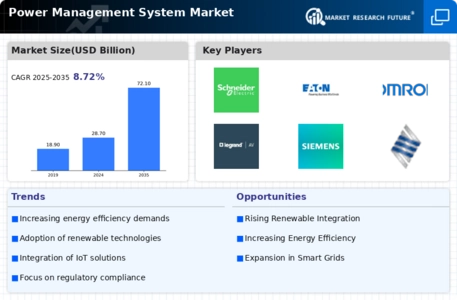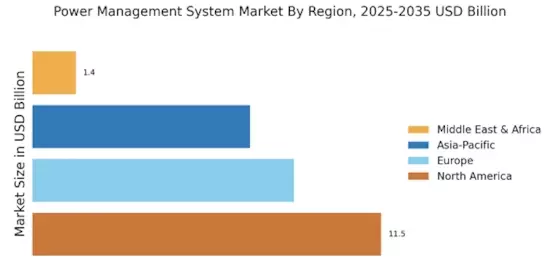The Power Management System Market is currently characterized by a dynamic competitive landscape, driven by the increasing demand for energy efficiency and sustainability across various sectors. Key players such as Schneider Electric (France), Siemens (Germany), and General Electric (United States) are at the forefront, each adopting distinct strategies to enhance their market positioning. Schneider Electric (France) emphasizes digital transformation and innovation, focusing on smart grid technologies and IoT integration. Siemens (Germany) leverages its extensive portfolio in automation and digitalization, aiming to provide comprehensive solutions that enhance operational efficiency. General Electric (United States) is concentrating on renewable energy integration, aligning its offerings with global sustainability goals. Collectively, these strategies not only shape their competitive environment but also drive the market towards more advanced and sustainable power management solutions.
In terms of business tactics, companies are increasingly localizing manufacturing and optimizing supply chains to enhance responsiveness to market demands. The competitive structure of the Power Management System Market appears moderately fragmented, with several key players exerting substantial influence. This fragmentation allows for a diverse range of solutions, catering to various customer needs while fostering innovation through competition.
In August 2025, Schneider Electric (France) announced a strategic partnership with a leading renewable energy firm to develop integrated power management solutions that enhance grid resilience. This collaboration is significant as it aligns with the growing trend towards renewable energy sources, positioning Schneider Electric as a leader in sustainable power management. The partnership is expected to facilitate the development of innovative solutions that address the challenges of energy transition.
In September 2025, Siemens (Germany) launched a new digital platform aimed at optimizing energy consumption in industrial settings. This initiative is crucial as it reflects Siemens' commitment to digitalization and its potential to transform energy management practices. By providing real-time analytics and insights, the platform is likely to enhance operational efficiency and reduce costs for industrial clients, thereby strengthening Siemens' competitive edge in the market.
In July 2025, General Electric (United States) expanded its portfolio by introducing advanced energy storage solutions designed to support renewable energy integration. This move is particularly relevant as it addresses the growing need for reliable energy storage systems, which are essential for balancing supply and demand in a renewable-heavy grid. By enhancing its offerings in this area, General Electric positions itself as a key player in the transition towards a more sustainable energy landscape.
As of October 2025, the Power Management System Market is witnessing trends such as digitalization, sustainability, and AI integration, which are redefining competitive dynamics. Strategic alliances among key players are increasingly shaping the landscape, fostering innovation and collaboration. Looking ahead, competitive differentiation is likely to evolve from traditional price-based competition to a focus on innovation, technology, and supply chain reliability, as companies strive to meet the demands of a rapidly changing energy environment.


















Leave a Comment